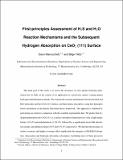First-Principles Assessment of H[subscript 2]S and H[subscript 2]O Reaction Mechanisms and the Subsequent Hydrogen Absorption on the CeO[subscript 2](111) Surface
Author(s)
Marrocchelli, Dario; Yildiz, Bilge
DownloadMarrochelli and Yildiz-H absorption into CeO2-accepted to J Phys Chem.pdf (4.484Mb)
PUBLISHER_POLICY
Publisher Policy
Article is made available in accordance with the publisher's policy and may be subject to US copyright law. Please refer to the publisher's site for terms of use.
Terms of use
Metadata
Show full item recordAbstract
The main goal of this study is to assess the resistance of ceria against hydrogen penetration into its bulk, in the context of its application as a protective surface coating against hydrogen embrittlement in metals. We evaluate the reaction mechanisms between the H[subscript 2]S and H[subscript 2]O molecules and the CeO[subscript 2](111) surface and their kinetic descriptors, using first principles based calculations in the density functional theory framework. Our approach is validated by performing an extensive comparison with the available experimental data. We predict that hydrogen penetration into CeO[subscript 2](111) is a surface-absorption-limited process with a high-energy barrier (1.67 eV) and endothermicity (1.50 eV), followed by a significantly lower bulk dissolution energy and diffusion barrier (0.67 and 0.52 eV, respectively). We find that the presence of surface vacancies and higher coverages affects significantly the energetics of H[subscript 2]S/H[subscript 2]O adsorption, dissociation, and hydrogen subsurface absorption, facilitating most of these processes and degrading the protectiveness of ceria against hydrogen penetration. The reasons behind these effects are discussed. Overall we expect ceria to hinder the hydrogen incorporation significantly due to the effectively large energy barrier against subsurface absorption, provided vacancy formation is suppressed.
Date issued
2011-12Department
Massachusetts Institute of Technology. Department of Nuclear Science and Engineering; Massachusetts Institute of Technology. Laboratory for Electrochemical InterfacesJournal
The Journal of Physical Chemistry C
Publisher
American Chemical Society (ACS)
Citation
Marrocchelli, Dario, and Bilge Yildiz. “ First-Principles Assessment of H 2 S and H 2 O Reaction Mechanisms and the Subsequent Hydrogen Absorption on the CeO 2 (111) Surface .” The Journal of Physical Chemistry C 116, no. 3 (January 26, 2012): 2411–2424.
Version: Author's final manuscript
ISSN
1932-7447
1932-7455